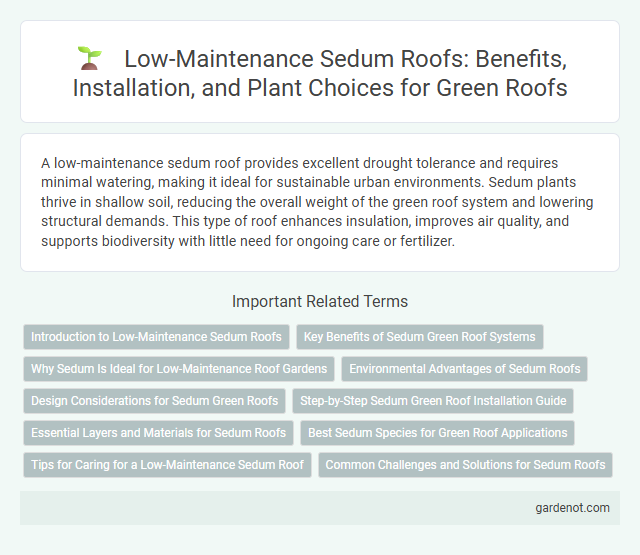A low-maintenance sedum roof provides excellent drought tolerance and requires minimal watering, making it ideal for sustainable urban environments. Sedum plants thrive in shallow soil, reducing the overall weight of the green roof system and lowering structural demands. This type of roof enhances insulation, improves air quality, and supports biodiversity with little need for ongoing care or fertilizer.
Introduction to Low-Maintenance Sedum Roofs
Low-maintenance sedum roofs consist of drought-tolerant succulent plants that require minimal watering and care, making them ideal for sustainable urban environments. These green roofs enhance insulation, reduce stormwater runoff, and improve air quality while thriving in nutrient-poor substrates. Their shallow root systems and hardy nature enable long-lasting vegetation cover with reduced maintenance costs compared to conventional green roof options.
Key Benefits of Sedum Green Roof Systems
Sedum green roof systems offer excellent durability and drought resistance, reducing the need for frequent watering and extensive upkeep. Their shallow root systems and adaptability to various climates make them ideal for low-maintenance applications on commercial and residential buildings. Sedum roofs also enhance energy efficiency by providing natural insulation and improve urban air quality through effective pollution filtration.
Why Sedum Is Ideal for Low-Maintenance Roof Gardens
Sedum plants thrive in shallow soil and withstand extreme weather conditions, making them ideal for low-maintenance green roofs. Their drought-resistant properties reduce the need for frequent watering, while their shallow root systems minimize roof damage. Sedum's natural ability to promote biodiversity and improve insulation enhances the sustainability and energy efficiency of roof gardens.
Environmental Advantages of Sedum Roofs
Sedum roofs offer significant environmental benefits including enhanced stormwater management by absorbing and filtering rainwater, reducing runoff and alleviating pressure on urban drainage systems. Their dense, drought-resistant vegetation improves air quality by trapping dust and pollutants while providing thermal insulation that lowers building energy consumption. These low-maintenance green roofs also promote biodiversity by creating habitats for pollinators, supporting urban ecosystems with minimal irrigation or upkeep requirements.
Design Considerations for Sedum Green Roofs
Sedum green roofs require careful design considerations including substrate depth, drainage systems, and plant selection to ensure low-maintenance performance and longevity. Optimal substrate depth for sedum roofs typically ranges from 4 to 6 centimeters, providing adequate water retention and root support while minimizing weight load. Proper drainage layers and drought-resistant sedum species like Sedum album and Sedum acre enhance resilience and reduce irrigation needs in various climatic conditions.
Step-by-Step Sedum Green Roof Installation Guide
A low-maintenance sedum roof requires careful preparation, including ensuring proper waterproofing and installing a root barrier before laying the drainage layer. Next, apply a lightweight growing medium optimized for sedum plants, followed by arranging sedum mats or plugs evenly to promote quick coverage and healthy growth. Regular inspections during the first growing season help monitor moisture levels and establish the plants, ensuring a durable and sustainable green roof system.
Essential Layers and Materials for Sedum Roofs
Sedum roofs require carefully designed essential layers including a waterproof membrane, root barrier, drainage layer, filter fabric, and a lightweight growing medium tailored for sedum plants. These materials ensure proper water retention, root protection, and nutrient supply while minimizing upkeep. The combination of specialized substrates and sediment-tolerant sedum varieties creates a durable, low-maintenance green roof system.
Best Sedum Species for Green Roof Applications
Low-maintenance sedum roofs thrive with species such as Sedum album, Sedum spurium, and Sedum sexangulare, known for drought tolerance and hardiness in various climates. These sedum varieties offer excellent ground coverage and require minimal irrigation, making them ideal for sustainable green roof installations. Their adaptability to shallow substrates enhances structural longevity while promoting biodiversity and urban cooling benefits.
Tips for Caring for a Low-Maintenance Sedum Roof
A low-maintenance sedum roof thrives with minimal watering, relying mainly on natural rainfall to prevent overwatering and root rot. Regular inspections should be conducted to remove weeds and debris that could hinder sedum growth and drainage efficiency. Fertilizing once or twice a year with a balanced, slow-release fertilizer supports healthy plant development without promoting excessive growth.
Common Challenges and Solutions for Sedum Roofs
Sedum roofs often face challenges such as uneven water distribution, weed invasion, and limited soil depth, which can impact plant health and roof longevity. Solutions include installing efficient irrigation systems, using pre-grown sedum mats to minimize weed growth, and employing lightweight soil substrates designed for optimal drainage and root support. Regular inspections and timely maintenance ensure the sedum roof remains resilient against drought, pests, and extreme weather conditions.
Low-maintenance sedum roof Infographic

 gardenot.com
gardenot.com